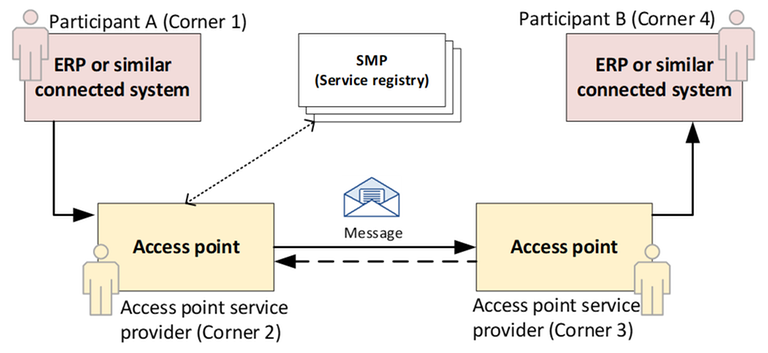- Startsida
- SFTI
- Peppol
- The Peppol transport model
- General information
General information
This section contains general information on the transport model and its benefits.
Actors and Roles
Role | Description |
|---|---|
Participant | The organization that exchanges messages with another Participant in a collaboration process. |
Access Point Service provider | The organization that performs access point functions for message mediation on behalf of Participants. |
Architecture Style
Peppol's 4-corner model allows Participants in the infrastructure to use service providers that provide access point functions.

Illustration of the 4-corner model and its roles
Message exchange in this transport model is asynchronous between the Participants' systems (but synchronous between the access points), which means that any response (e.g., the supplier's order acknowledgment in response to the buyer's order) is returned as a new transmission.
Dynamic lookup is performed for message addressing against service registries. Service registries (SMP, Service Metadata Publishers) publish signed information about the Participant's technical endpoint/receiving point. This information is used by the sending access point to prepare (encrypt/sign) the payload and send it to the correct address.
Peppol's infrastructure has many service registries, and to select the right one, the access point uses the central locator service (SML, Service Metadata Locator + DNS).
Messages sent through Peppol's infrastructure are always packaged in a technical envelope (SBDH, Standard Business Document Header) containing information about the sender and receiver's identity and the message type.
How the Peppol Transport Model Works
The electronic business message (e.g., an e-invoice) is enveloped in accordance with the SBDH standard and transmitted via access point functions using the AS4 protocol. The sending access point function performs an address lookup against the SMP service. Subsequently, the message is transmitted to the receiving access point function, which immediately acknowledges (synchronously) that the message has been received. The message is then handed over to the Participant's business system, which checks that the message conforms to the current message specification.
The security mechanisms for transmission (signed and encrypted) between access point functions are specifically regulated by Peppol's transport protocol (AS4). Peppol does not regulate specific security mechanisms regarding encryption/signing for the integration between the Participant and its Access Point service provider, other than both parties must ensure that the integration is done securely (internal security as stipulated in Peppol's agreement model).
Conditions of Use
The transport model is based on an asynchronous exchange pattern, making it suitable for situations where the Participants' business systems should/must be loosely coupled to each other.
Peppol's transport model provides high security through the use of standardized security mechanisms and the responsibilities of the parties involved are specified and documented. In exceptional cases, it may be necessary to ensure a higher level of trust for information exchange. If two Participants need to exchange sensitive information, they can jointly review and demonstrate how their respective internal security is guaranteed. Such a review may involve the Participants showing which security mechanisms are used in the integration with the access point service provider, the legal requirements applicable in the context, and other security-related requirements.
Benefits
Below are examples of benefits enabled by using the functions and services stipulated by the transport model.
4-corner model provides
The ability for Participants to use a service providers for technical communication (transmission).
The ability for service providers to establish economies of scale as they can offer the same service to multiple customers.
The ability to have a looser coupling between the Participants' systems with asynchronous transmission, placing lower demands on availability.
Use of SML/SMP provides
Automated retrieval of technical address information from a current and secure source.
The ability to check if the recipient supports the current message type and collaboration process.
Dynamic addressing that makes it easy for Participants to switch solutions without needing to change static/hard-coded configurations with counterparts.
Use of the technical envelope SBDH provides
The access point service providers with the ability to manage incoming and outgoing messages rationally.
A standardized way to identify the parameters needed for a query in SML/SMP.
Further information
See Peppol Interoperability Framework
